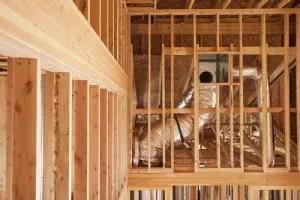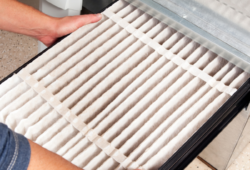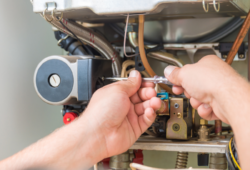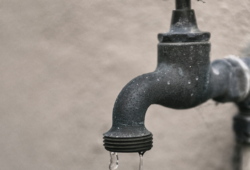Home Ventilation: Why It’s Imperative and What Your Options Are
Summer heat and year-round humidity are just part of the deal of living in Raleigh, Wake Forest, and elsewhere in our corner of North Carolina. While there isn’t much we can do about the weather, there are plenty of ways to protect your home and improve your comfort.
One of the most effective methods is a carefully planned home ventilation system. Good indoor airflow keeps you more comfortable in both hot and cold weather, removes contaminants from your air, and prevents moisture damage to your home.
Ventilation Protects Your Health and Your Home

No matter how little you open your windows and doors, a certain amount of pollen, mold spores, city smog, and other contaminants will find their way in. In a well-ventilated home, these air contaminants never have a chance to build up to levels that could affect your health.
In addition to pollutants in the outdoor air, there are contaminants produced within your home. A buildup of dust mites can aggravate allergies and asthma. Worse yet are the volatile organic compounds (VOCs) given off by many household items. VOCs are chemical fumes, such as formaldehyde, toluene, and xylene produced by carpeting, upholstery, paint, and many other materials, especially when new. Air fresheners, cosmetics, and even newspapers add to your home’s VOC load. Many of these chemicals are known carcinogens.
A higher-efficiency air filter in your air conditioner and furnace goes a long way toward removing particles such as mold spores, but it does nothing against smog, VOCs, and other gaseous pollutants. Filtration alone can’t ensure high indoor air quality. A home ventilation system improves your air quality by drawing out contaminated air and replacing it with fresh air. Your air will not only smell fresher, but will also be better for your health.
Because consistent airflow removes humidity as well as air contaminants, it reduces the risk of moisture problems such as rot and mold. Your home will need less frequent repairs, saving you both money and time.
As you’ve no doubt experienced, summertime high humidity leaves you feeling hot and sticky, increasing your need for air conditioning. With healthier humidity levels, you can turn down your A/C and cut your cooling bills without reducing your comfort.
How Poor Ventilation Harms You
Without good home ventilation, you’re at risk for problems far greater than funny odors and a little summertime discomfort.
Air leakage – Many older homes were intentionally built with gaps around the doors, windows, and walls that were meant to allow air to flow in and out of the building. While this crude ventilation method does provide a minimum of airflow, it often creates more problems than it solves. Leaks let in unfiltered air that contains dust, allergens, and other pollutants.
In summer, they let your air conditioned air escape as hot, humid outdoor air enters. In winter, they let out your warm air. Needless to say, this makes it much harder to keep your home a comfortable temperature. Gaps and cracks also let in household pests such as cockroaches and mice. A well-designed home ventilation system provides airflow without the need for leaks.
Carbon monoxide – Even with proper maintenance and use, fuel-burning appliances release a certain amount of carbon monoxide (CO) into your home. As long as you have good airflow, this CO never builds up to a harmful level. Without sufficient home ventilation, however, you may experience symptoms of low level CO exposure, such as dull headaches and fatigue.
If your home has air leaks, the air pressure imbalance these leaks cause can prevent your appliances from properly venting their exhaust fumes. Instead, the fumes may be drawn back into your home, further increasing your risk of CO exposure.
Moisture issues – In Raleigh’s subtropical climate, humidity is a nearly constant concern, but it’s far more than a comfort issue. Over time, high humidity levels in your home can seriously damage wood, dry wall, insulation, and other building materials. Moisture also encourages the growth of mold, which causes even more damage by gradually eating away at the surface on which it grows.
In summer, air leaks let in warm, moist outdoor air. When this warm air hits the cool walls and other surfaces of your air conditioned house, it creates condensation, further increasing the moisture level and related problems. Good ventilation removes both excess humidity and mold spores, protecting your home from damage.
Natural ventilation: Using Wind and Warm Air
Natural ventilation takes advantage natural phenomena to create airflow through a building. The most basic method is simply opening windows on opposite sides of the house to allow a cross breeze. Because this brings in air contaminants and creates uncomfortable drafts, more effective natural ventilation systems have been developed.
Trickle ventilation is a type of wind-driven ventilation that uses small vents above the windows to allow airflow while blocking most contaminants and minimizing drafts.
Stack ventilation is a type of buoyancy ventilation, meaning it relies on the tendency for warm air to rise. The system uses trickle vents on the lower levels of your home to let in cool, fresh air and stack vents on the roof to allow warm, stale air to flow upward and out of your home.
While natural ventilation can provide essential airflow and won’t cost you anything in electricity, the drawback is that it’s impossible to control. On hot, windless days, you may be left with too little fresh air.
Spot Ventilation: Affordable and Practical
Building codes ensure that nearly all homes have some spot ventilation. These are the electric fans you’ll find in the walls of your bathroom and kitchen. Running these fans for a few minutes after showering or cooking is a simple and effective way to get rid of built up moisture and odors. They draw out contaminants faster and offer more control than natural ventilation, but they aren’t enough to ensure good airflow throughout your whole home.
The small size of these fans mean they have only enough capacity to clean the air in a single small room. Letting them run for longer periods isn’t a good alternative. As they run, spot vents let in a small amount of unfiltered outdoor air. This is insignificant when you’re trying to get rid of a concentration of moisture or pollutants from one area. Over more than five or 10 minutes, though, the fans will let in more air contaminants than they remove.
Whole-House Ventilation: Clean Air in Every Room
If you want a home ventilation system that can freshen the air everywhere in your home and that allows you to control how much airflow your home receives, consider a whole-house system. For whole-house airflow, there are three types of ventilation systems:
Exhaust-only – This type of system draws out stale air, but relies on air leaks to let in fresh air. It’s best used in cold climates.
Supply-only – This system brings in fresh outdoor air and relies on spot ventilation fans and air leaks to let out stale air. It’s a good choice for a hot, humid climate because it allows for the filtration and dehumidification of incoming outdoor air. Because it doesn’t create negative air pressure indoors, it presents less risk of drawing appliance exhaust fumes into your home compared to an exhaust-only system.
Balanced – A balanced ventilation system is designed to both exhaust stale air and bring in fresh air in a controlled manner. With one of these systems, you can air seal the leaks around your home to improve air quality and energy efficiency without sacrificing airflow. A balanced system is appropriate for any climate, but compared to exhaust and supply systems, it’s more complex and therefore more expensive to design and install.
For even greater control over your ventilation and indoor air quality, consider a heat recovery ventilator (HRV) or energy recovery ventilator (ERV). A HRV contains a heat exchanger that, in winter, allows it to extract warmth from the heated outgoing air and move it into the incoming outdoor air. In summer, it does the reverse. This helps maintain your indoor temperatures, saving you money on heating and cooling.
An ERV goes one step further. This home ventilation system transfers not only heat, but also humidity. This is particularly useful in summer, when the system helps keep down your indoor humidity levels. Keep in mind, however, that an ERV isn’t a substitute for a dehumidifier.
The ideal home ventilation system for your needs depends on your exact location your home’s design, and your lifestyle. For professional guidance on choosing the right system, contact us at Air Experts in the Raleigh, Holly Springs, Garner, and Fuqua-Varina areas.
Image Provided by Shutterstock.com




